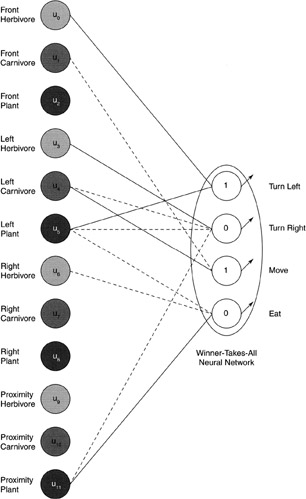Sample Iteration
Let's now look at a sample action-selection iteration of an evolved agent. In this example, we'll look at an herbivore that has evolved during the simulation. While not perfect, this particular agent survived in the environment for over 300 time steps. It was able to do this by avoiding predators (carnivores) as well as finding and eating plants. Figure 7.6 shows the neural network for this agent.

Figure 7.6: Neural network for evolved herbivore.
Solid lines in the neural network are excitory connections, while dashed lines are inhibitory. Within the output cells are the biases that are applied to each output cell as it is activated. From Figure 7.6, we can see that an excitory connection exists for the eat action when a plant is in proximity (a plant can only be eaten when it is in proximity of the agent). Also of interest is the inhibitory connection for the move action when a carnivore is in front. This is another beneficial action for the survival of the herbivore.
An agent's actions are not formed by a single connection. Instead, the action with the largest value is permitted to fire based upon the combination of the sensor inputs. Let's look at a couple of iterations of the herbivore described by the neural network in Figure 7.6.
Recall from Equation 7.1 that we multiply the weights vector (for the particular action) by the inputs vector and then add the bias.
In our first epoch , our herbivore is presented with the scene as shown in Figure 7.7. The different zones are shaded to illustrate them (recall Figure 7.4). In this scene, the 'X' denotes the location of the herbivore (its reference point to the scene). A plant is located within proximity and a carnivore is located in front.

Figure 7.7: Herbivore at time t .
The first step is assessing the scene. We count the number of objects of each type in each of the four zones. As shown in Figure 7.7, the weights and inputs are labeled with type/zone (HF is herbivore- front , CF is carnivore- front, PP is plant-proximity, etc.). In this example, our input's vector has nonzero values in only two of the vector elements. As shown in the scene, these are a carnivore in the front zone and a plant in proximity.
To evaluate the function to take, we multiply the input vector by the weights vector for the defined action and then add in the respective bias. This is shown below in Figure 7.7. Per our action-selection algorithm, we take the action with the largest resulting value. In the case of a tie, as is shown in Figure 7.7, we take the largest value that appeared last. In this case, the eat action is performed (a desirable action given the current scene).
Once the plant is consumed, it disappears from the scene. The herbivore is then left with the scene as shown in Figure 7.8.

Figure 7.8: Herbivore at time T 1 .
The scene is assessed once again, and as shown, the plant no longer exists, but the carnivore remains. This is illustrated by the inputs (changes are shown in bold from the prior iteration). We again compute the output cells of the neural network by multiplying the input vector times the respective weights vector. In this case, the largest value is associated with the left action. Given the current scene, this is a reasonable action to take.
Finally, in Figure 7.9, we see the final iteration of the herbivore. Note that the agent's view has changed because it changed direction in the last iteration. With the change in the scene, the inputs have now changed as well. Instead of a carnivore in the front zone, it has moved to the right zone due to our new view of the scene.

Figure 7.9: Herbivore at time T 2 .
Computing the output cells once again results in the move action being the largest, but more importantly, last in this case. The herbivore's behavior allowed it to find food and eat it, and then avoid a carnivore within its field of view. From this short demonstration of the herbivore's neural network, it is not surprising that it was able to navigate and survive in the environment for a long period of time.
| On the CD | The source for the Alife simulation can be found on the accompanying CD-ROM at ./software/ch7. |
EAN: 2147483647
Pages: 175